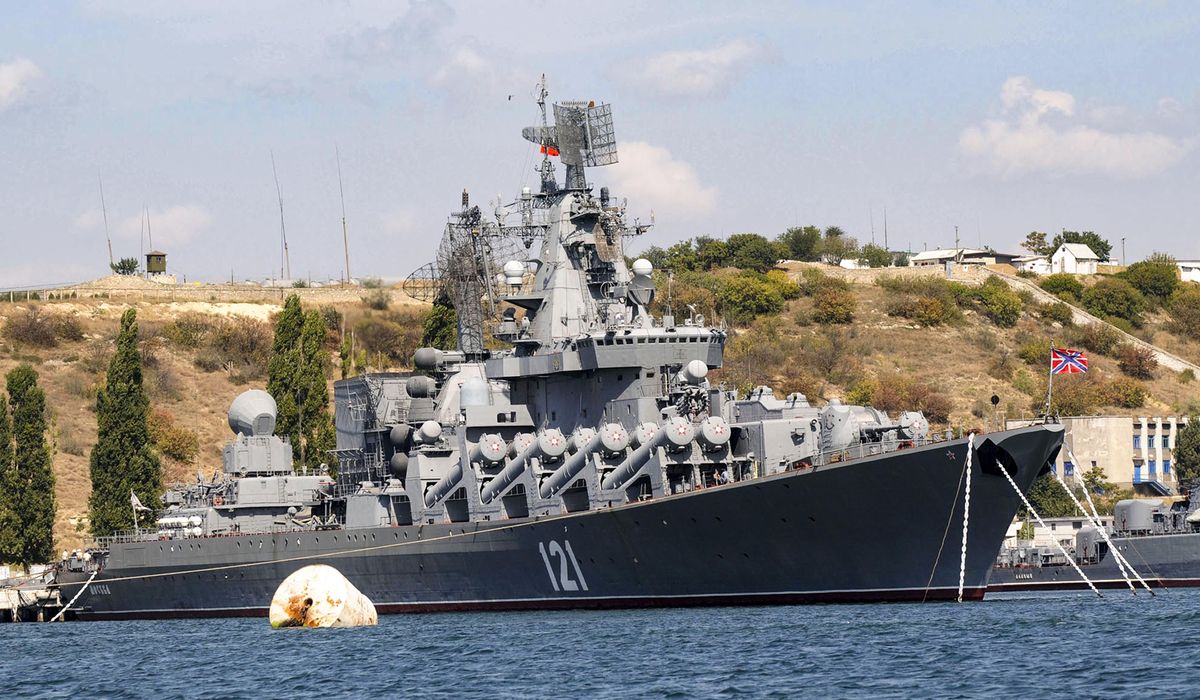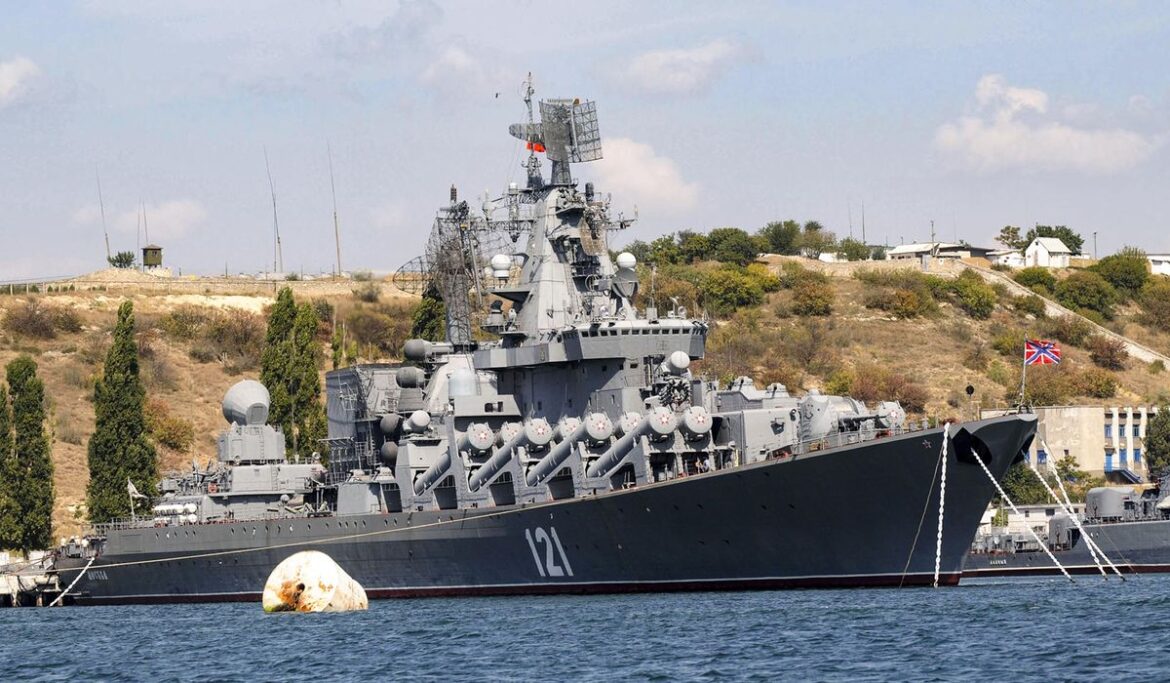
An invasion of Ukraine that has not gone according to Russia‘s plans took another high-profile hit Thursday as the flagship of the Kremlin’s Black Sea fleet sank and President Biden hinted he may visit Ukraine in the coming days to bolster the government of President Volodymyr Zelenskyy.
Mr. Biden hinted at a possible trip to White House reporters just hours before Russia‘s Defense Ministry confirmed that the guided-missile cruiser Moskva had sunk, with officials in southern Ukraine saying that a home-made Neptune missile had badly crippled the warship.
Pentagon officials said Thursday they could not confirm what had caused a massive fire aboard the heavily-armed vessel with a crew of 500 sailors, but it sank after Russian officials unsuccessfully tried to tow it out of Ukrainian waters and back to Russian-controlled Crimea for repairs.
SEE ALSO: DOJ charges Russian lawmaker, staff in conspiracy to influence Congress
The Moskva “lost its stability when it was towed to the port because of the damage to the ship’s hull that it received during the fire from the detonation of ammunition. In stormy sea conditions, the ship sank,” Russia‘s Defense Ministry said in a statement.
The Moskva was one of just three warships of its class in the Russian navy.
Its sinking came as Russian forces were still regrouping and redeploying for an expected new offensive after the initial phase of their invasion, which began Feb. 24, stalled badly outside Kyiv and other major cities of the north.
Oleksiy Arestovych, an adviser to Ukraine‘s president, called the ship’s sinking an event of “colossal significance.”
Admitting U.S. officials were still trying to determine exactly what had happened to the Moskva, White House National Security Advisor Jake Sullivan added, “certainly, the way this unfolded, it’s a big blow to Russia.”
Armed with 16 long-range cruise missiles, deck guns, torpedoes and mortars, the Moskva was considered the premier vessel in the Russian Black Sea fleet, which has largely bottled up Ukraine‘s navy since the fighting began.
It took part in the operation when Mr. Putin seized Crimea from Ukraine in 2014 and also saw action as part of the Russian military force backing President Bashar Assad in Syria’s brutal civil war.
Russian President Vladimir Putin is said to be feeling a growing sense of urgency to show more progress in the military campaign as his forces batter Ukrainian towns, but recent days have brought some ominous developments.
The Pentagon confirmed Thursday it was organizing a training mission for Ukrainian troops to use a new package of sophisticated anti-tank missiles and other weaponry, while Mr. Putin’s top aides reacted angrily to the news that Sweden and Finland were seriously considering applying to join the NATO alliance soon.
The Biden administration has committed more than $3.2 billion in security assistance to Ukraine with most of it, about $2.6 billion, coming since the war began. The list includes a number of big-ticket items, such as 18 155mm howitzers and 40,000 artillery rounds; 11 Russian-made Mi-17 helicopters originally intended for the former Afghan government; and 200 M-113 armored personnel carriers.
“We’re working very hard at sourcing these things and getting them on the way to Ukraine as quickly as possible,” chief Pentagon spokesman John Kirby told reporters Thursday.
A trip by Mr. Biden or another senior U.S. official to Kyiv would come on the heels of recent visits by British Prime Minister Boris Johnson and Eastern European NATO leaders to the now more-secure Ukrainian capital.
Mr. Biden, who briefly crossed the Ukrainian border on a visit to Poland late last month, hinted he may make the trip while talking to reporters shortly before he boarded Air Force One for a trip to North Carolina.
Asked whether a top U.S. official would be going to Kyiv, Mr. Biden replied, “We’re making that decision now.” Asked then whether he was “ready” to go, the president answered, “Yes.”
Threatening NATO
Mr. Putin said repeatedly that one reason for the “special military operation” in Ukraine was to prevent the onetime Soviet republic from joining NATO.
The prospect that Sweden and Finland, which have long remained officially neutral while having some ties to the Western military alliance, would drop their historic reluctance to apply for NATO membership clearly set off fresh alarm bells in the Kremlin.
Former Russian President Dmitry Medvedev, now a top security adviser to Mr. Putin, vowed Thursday that Russia would beef up its military forces along its western borders if Sweden and Finland joined NATO, including increasing the number of ground troops and air defense systems in the region along with deploying “substantial” naval forces in the Gulf of Finland.
A longtime ally of Mr. Putin and now deputy chairman of Russia’s Security Council, Mr. Medvedev noted Thursday that the inclusion of Finland and Sweden would more than double NATO’s land border with Russia.
“Naturally, it will be necessary to strengthen those borders,” he said, according to the state-owned Tass news agency.
Mr. Medvedev denied that Russia’s nearly two-month-old invasion of neighboring Ukraine triggered the shift by Sweden and Finland, which have both seen popular support for NATO surge since February.
“The attempts to drag them into the alliance were made before,” he said. “Secondly, which is the main thing, we do not have territorial disputes with these countries like with Ukraine. This is why the value of such membership is different for us.”
Nuclear threats
Mr. Medvedev, who has issued a series of incendiary comments since the fighting in Ukraine began, also threatened to expand Russia‘s nuclear assets around the Baltic Sea if the two countries were admitted to the alliance.
“If this is the case, there can no longer be talk about the Baltic’s non-nuclear status. The balance must be restored,” he warned, according to Tass.
NATO Secretary-General Jens Stoltenberg said last year the alliance would welcome a bid by Sweden or Finland to join NATO, and repeated last week the door was open despite Russian opposition.
“It is for Finland and Sweden to decide whether they would like to apply for membership or not, and we will respect that decision,” Mr. Stoltenberg told reporters in Brussels last week. “If they decide to apply, I expect that all allies will welcome them.”
Finnish Prime Minister Sanna Marin, meeting with her Swedish counterpart Wednesday, said that Helsinki would decide on whether to apply for NATO within “weeks rather than months.”
CIA Director William Burns, in some of his most expansive public comments to date on the war, told a forum Thursday at the Georgia Institute of Technology that the nuclear warnings by Mr. Medvedev and other senior Russian officials had to be taken seriously, both because of the rising desperation of Mr. Putin over a war gone bad and because of Russia‘s arsenal or lower-yield “tactical” nuclear weapons he might be tempted to use.
Mr. Putin put his nuclear forces on an unspecified “higher alert” status as Western nations rushed to aid Ukraine in the invasion’s early days.
“None of us can take lightly the threat posed by a potential resort to tactical nuclear weapons or low-yield nuclear weapons,” Mr. Burns said, although he acknowledged U.S. intelligence analysts “haven’t seen a lot of practical evidence of the kind of deployments or military dispositions that would reinforce those concerns,” according to an account of his remarks by the Reuters news agency.
Separately, the Pentagon revealed that U.S. officials in Europe are setting up training programs to show Ukrainian soldiers how to operate some of the military supplies being sent to them as part of the just approved $800 million security assistance package.
‘Training the trainers’
On Thursday, a senior U.S. defense official told reporters in Washington that Ukrainian troops will likely require instruction to use the artillery and radar systems included on the list.
Ukraine will receive 18 towed howitzers along with 40,000 artillery rounds, 10 AN/TPQ-36 counter-artillery radars and two AN/MPQ-64 Sentinel air surveillance radars.
U.S. and allied supplies are credited with aiding the surprisingly tough resistance the Ukrainians have put up to date against a larger and better-armed Russian invading force.
“We do not assess that it’s going to take longer than a few days, max, to get them trained up on those systems,” the senior defense official told reporters.
Air Force Gen. Tod D. Wolters — who wears two hats as both head of U.S. European Command and NATO’s Supreme Allied Commander — is in charge of the training requirements. They will likely choose Ukrainian soldiers who already have some level of experience with artillery and radar to receive the training on the specifics of the American systems in the package, Pentagon officials said.
“It’s a ‘train the trainers’ approach. We’re not pulling out of Ukraine an exorbitant number of fighters. They don’t think this training is going to take very long to conduct,” the senior defense official said at a Pentagon background briefing.
Mr. Zelenskyy has repeatedly pressed NATO countries for more weapons to continue his nation’s fight against Russia. Mr. Biden and other NATO leaders have already ruled out contributing troops to the fight or establishing a no-fly zone over the former Soviet republic, for fear of sparking a direct shooting war with Moscow.
The training operation is being planned even as U.S. officials continue to locate the items on the latest list, which also includes 11 Soviet-era Mi-17 helicopters and such U.S.-sourced weapons as 200 M113 armored personnel carriers, 500 Javelin missiles and thousands of other anti-armor systems.
“Every single item is not going to have to come from the United States. Some could come from pre-positioned stocks that are elsewhere,” the senior defense official said.
The first weapons and tactical equipment on the list could be in the hands of Ukrainian soldiers in about a week, officials said.
— This article was based in part on wire-service reports.





